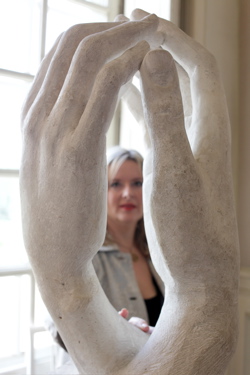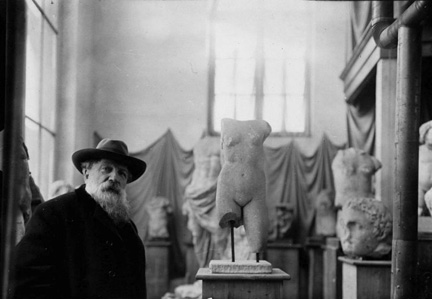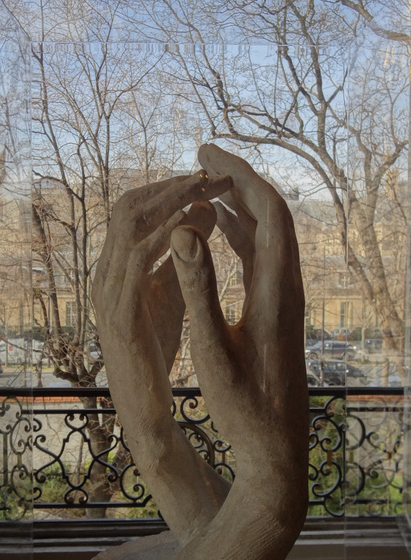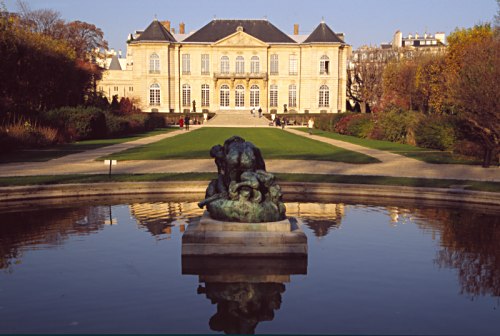French sculptor Auguste Rodin (12 November 1840 – 17 November 1917) had an ability to explore profound, spiritual themes through ostensibly simple forms – in this case, a pair of two hands. Rodin’s “Cathedral” or “Cathedral Hands” (1908) looks at the sacred space in which we explore life, death and spirituality with a refreshing emphasis on our humanity. “Cathedral” disposes of the grandiose symbol of an actual cathedral, rendering faith “human,” and thus, much more personal and fragile. Traditionally, the word “cathedral” evokes a religious sanctuary for thoughts on the preciousness of life and death in relation to a specific faith. But in “Cathedral” Rodin suggests a new idea: that perhaps, in our exploration of life and death, we need only look inside ourselves – inside the sanctuary of our minds, and the ‘cathedral’ that is the human body.
Unlike many of his impressionistic/post-impressionistic contemporaries, Auguste Rodin became a respected authority in the art world during his own lifetime – not to mention quite the celebrity for the general public. Rodin was sculpting pieces that would pay homage to figures of then contemporary literature, classic myths, and authors like Honore de Balzac; he interpreted grand biblical episodes and showed more intimate, quotidian moments in the sculptures of his love, Rose Beuret.
Though learned in a number artistic styles, Rodin reached a level of critical and public success with his sculptures that remains unparalleled; his nod to the ‘Greats’ like Michalangeo is prevalent in each piece, yet his deconstruction of the human body was a revolutionary notion.
“Cathedral” was realized many times by Rodin, but one element stayed the same: the fact that the sculpture is made up of two right hands, each belonging to two different figures. We can also draw some parallels between the “mysterious inner space” and the composition of classical gothic architecture, says the Rodin Museum of Paris, as both show an intense interest in emptiness that can evoke the absence of life and inescapable nature of death. Thus, Life in “Cathedral” is represented as the tender joining of two ‘right’ and honest hands, while Death becomes the empty space – and fate – that constantly surrounds it.
“Emptiness was a factor that Rodin used to allow for,” says the Rodin Museum, “[and] this work belongs to [a] series [of pieces] carved in marble, most frequently after 1900, such as “The Hand of God,” “The Hand of the Devil,” “Hands of Lovers” and “Hand from the Tomb.” But, more broadly, it emphasizes Rodin’s fondness and passion for these hands; he isolated them in order to give them a more autonomous form.” Another Rodin scholar pointed out that “the role of air had always been extremely important” to him, as it presents an opportunity to play with perception and symbolism by sculpting not just from stone, but seeing the air as a sort of medium as well (Rilke, 1928).
Can “Cathedral” bring us any insight into the personal views Auguste Rodin had on death? The sculpture shows an acknowledgement of our humanity that, one could argue, makes faith more human – and consequentially, reminds us of both the power and fragility of a human life. The French artist reminds us that no matter where or how we choose to consider our mortality, we all reflect in a ‘cathedral’ that transcends any faith: the human mind.
You may enjoy:
- A Woman’s War: The WWII Photographer of Lee Miller
- Jewish artist Marc Chagall’s painting, “The Death”
- Pierre Christin on Images of Death in Comics: French graphic novelist explains how comic book illustrations affect our perception of death

 Reflections on Life & Death in Auguste Rodin’s “Cathedral”
Reflections on Life & Death in Auguste Rodin’s “Cathedral”






 The Other Death in the Family
The Other Death in the Family

 The Healing Sound of Singing Bowls
The Healing Sound of Singing Bowls














